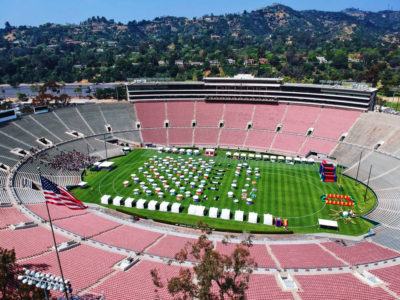Discovering the Rich Heritage of the Pasadena Rose Bowl

Few spectacles, indeed, rival the Rose Bowl in the realm of American athletics. Widely recognized as the “Granddaddy of Them All,” this iconic collegiate football event has, over time, woven itself into the rich tapestry of sports history. From its modest beginnings to its current, esteemed status as a symbol of athletic excellence, the Rose Bowl represents more than just a game. Along the way, it has shaped traditions, defined legacies, and captivated generations of fans.
Origins:
The Rose Bowl’s genesis dates back to the early 20th century, when Pasadena, California, sought to showcase its delightful winter climate. In 1890, the Valley Hunt Club organized the inaugural Tournament of Roses, featuring a parade adorned with exquisite floral displays. This success inspired the inclusion of a football contest to attract more visitors.
The Inception of a Tradition:
On January 1, 1902, the first Rose Bowl Game unfolded at Tournament Park in Pasadena. The inaugural match pitted the University of Michigan against Stanford University, resulting in a resounding triumph for Michigan with a score of 49-0. Despite the one-sided outcome, the event laid the groundwork for future iterations of the competition.
Transition to the Rose Bowl Stadium:
In 1923, the Rose Bowl found its permanent home with the completion of the stadium. This majestic venue, with its iconic horseshoe layout and breathtaking backdrop of the San Gabriel Mountains, provided an idyllic setting for the annual gridiron clash. Since then, the stadium has become synonymous with the Rose Bowl, witnessing numerous unforgettable moments.

Growing Influence:
As collegiate football’s popularity soared, so did the prominence. In 1947, the game made its nationwide television debut, captivating millions of viewers with its exhilarating action. This exposure propelled the Rose Bowl to its status as one of the premier events in American sports.
Time-Honored Traditions:
Beyond athletics, the Rose Bowl is renowned for its enduring traditions and extravagant pageantry. Transitioning from the realm of sports to cultural celebration, the Tournament of Roses Parade precedes the game, showcasing intricately crafted floats, marching bands, and equestrian ensembles. Furthermore, these festivities contribute significantly to the enchantment of the Rose Bowl experience, creating lasting memories for participants and spectators alike.
Legendary Moments:
Throughout its illustrious history, the Rose Bowl has witnessed an array of iconic moments. From stellar performances by Heisman Trophy recipients to thrilling come-from-behind victories, the game has delivered suspense and excitement. Whether it’s the “Granddaddy of Them All” or a pivotal matchup in the College Football Playoff era, the Rose Bowl continues to serve up unforgettable moments.
Legacy and Influence:
Beyond its role as a sporting spectacle, the Rose Bowl holds a special place in the cultural landscape of America. Beyond athletics, the Rose Bowl symbolizes tradition, excellence, and community. It unites people from all walks of life. Together, they celebrate competition and camaraderie. Furthermore, the Rose Bowl has come a long way. From modest beginnings to global recognition, it now stands tall. Ultimately, it proves the lasting power of sport to bring people together and inspire.
The Rose Bowl’s illustrious history reflects its distinct place in American sports. Evolving from humble beginnings to a cultural cornerstone, it has captivated fans across generations. As we eagerly anticipate each new game, we continue to witness its timeless significance.





As USC football fans we spent many New Year’s Day’s at the Rose Bowl when I was a kid. And then I took my kids when they were older too. Very fond memories for me.